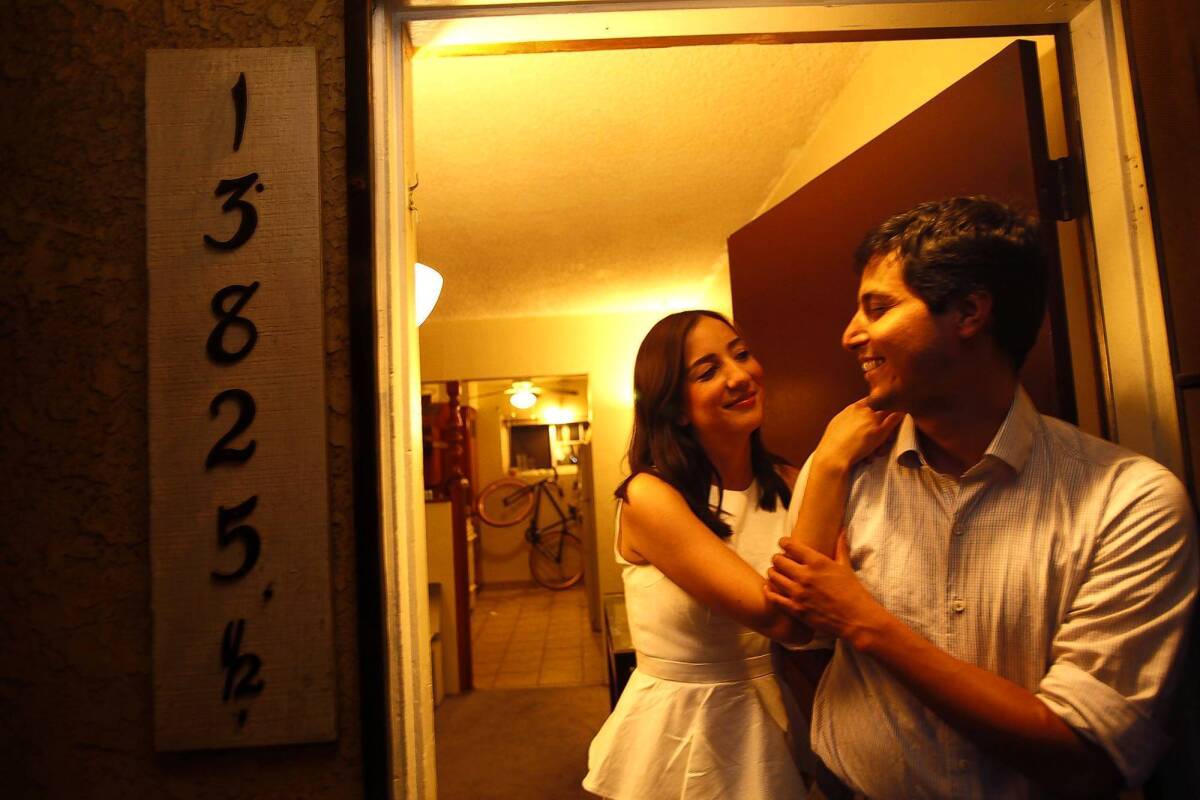Interracial couples increasingly common, though many aren’t marrying

- Share via
When Berto Solis and Nancy Thuvanuti met, nobody thought they would last, he remembers.
She was a New Jersey girl with Thai and Irish roots, a fashionista streak and a family full of university graduates. He was “rough around the edges,” he remembers, a Mexican American first in his family to go to college, a San Joaquin Valley transplant still trying to find himself.
“Everyone was like, ‘Her? Him?’” Solis said, now six years later. “But whenever we just let ourselves be, we said, ‘I don’t know what they’re talking about. We have more in common than they do.’”
More Americans are forming serious relationships across lines of race and ethnicity, moving in with or marrying people who check a different box on their census form. Married or unmarried, interracial couples were more than twice as common in 2012 than in 2000, U.S. Census Bureau data show.
Yet not all kinds of relationships are as likely to cross those lines. Racially and ethnically mixed couples are much more common among Americans who are living together, unmarried, than those who have tied the knot, a Census Bureau analysis released last week shows.
Last year, 9% of unmarried couples living together came from different races, compared with about 4% of married couples. The same gap exists for Latinos — who are not counted as a race by the Census Bureau — living with or marrying people who aren’t Latino.
Earlier studies have shown that even among younger couples, Americans are more likely to cross racial lines when they move in together than when they marry. Scholars are still puzzling over why, musing that interracial couples may face added barriers to marrying — or may be less impatient to do so.
Some researchers believe the numbers are tied to continued challenges for interracial and interethnic couples in gaining acceptance from friends and family. Marriage can bring family into the picture — and stir up their disapproval — in ways that rooming together does not.
Living together, “you don’t need to get a blessing from either side of the family,” said Zhenchao Qian, a sociology professor at Ohio State University. “Moving to the next stage is sometimes more difficult.”
Many older Americans, especially whites, are still uneasy about interracial marriage, a Pew Research Center study released three years ago showed. Only about half of white respondents ages 50 to 64 said they would be fine with one of their relatives marrying someone of any other race or ethnicity.
Some couples were stunned when their families objected to them marrying, having never heard their parents speak ill of other races, Stanford University sociologist Michael J. Rosenfeld found in interviews. But for those parents, it was a different matter when it came to their own children.
Other families may fear losing their culture to intermarriage. After Damon Brown met the woman who would become his wife, members of both families worried they would drift from their roots.
“That seemed to be the more common concern — that it’s a zero-sum game,” said Brown, an African American man married to an Indian American woman. Family members seemed to think that “you can be black, or you can be Hindi.”
They slowly showed their families that their cultures had plenty in common, and married last year, celebrating with Bollywood dancing and the line dancing he grew up with in New Jersey.
But couples who cannot gain such acceptance might delay marriage or decide against it, thinking, “This is going to be rough for the rest of our lives,” Brown said.
Other couples might not feel they need to get married — at least not right away. Now living in Norwalk together, Solis and Thuvanuti say their families have welcomed their relationship. But as twentysomethings, they don’t see any rush to get married.
Several scholars — and couples themselves — suggested people who are open to finding love outside their own race may be more willing to buck tradition by waiting to marry or not marrying at all.
“If you’re less traditional” in general, said Daniel T. Lichter, director of the Cornell Population Center, “maybe you’re more accepting of an interracial romance.”
In San Diego, Brooke Binkowski, who is white, has cut off friends who said offensive things about her live-in Latino boyfriend, such as, “He must need to get married pretty soon.... Doesn’t he need his green card?”
But such frustrations aren’t why they haven’t gotten hitched, the 36-year-old said.
“We just agreed it was not our thing at the time,” Binkowski said. “We didn’t want to progress in a traditional way.”
Being willing to resist tradition could also help explain why interracial relationships are even more common among same-sex couples — 12% of which are interracial — than among heterosexual couples.
Qian said gays and lesbians also have a smaller “marriage market,” possibly making them more likely to explore relationships with people of other racial and ethnic backgrounds.
More to Read
Sign up for Essential California
The most important California stories and recommendations in your inbox every morning.
You may occasionally receive promotional content from the Los Angeles Times.












